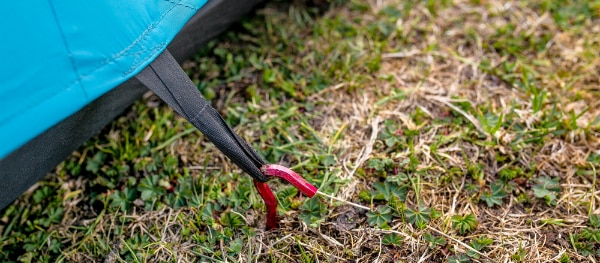Help! Which peg do I need?
17 October, 2017
Whether you want to set up a compact pop-up tent, the large awning on the front of your caravan or the canopy on your motorhome, you can’t do it without pegs. Anyone who’s regularly pounded those long, skinny devils into the ground knows that not every peg is right for every surface. That means that the standard pegs that often come with your tent aren’t always the best option. With so many options on the market, buying the right type for your camping needs can be tricky. But not anymore…
In this overview of the most important types of pegs, you’ll learn which ones are right for which surfaces and tent types.
The wooden peg
If you’re a long-time camper, you may still have them: the old-fashioned wooden pegs. Though they are quite strong, they do come with a few disadvantages. They’re heavy and can splinter. These days, there are improved versions on the market that are perfect for sandy or clay-like surfaces. Wooden pegs are great for marshy ground, as well.

The ground peg
The classic model that everyone knows so well. This standard peg is extremely versatile and is relatively easy to use in both hard and softer soils. They’re great for anchoring your inner tent and ground sheet, because they drive so deep into the ground and stay out of your way. They don’t work as well for awnings or canopies, where you’re better off with a stronger ground peg, like the square version.
The metal tent peg
These are often bent or serrated pegs that will stay better anchored into the ground. They work for all kinds of tents and canopies. Is there clay soil or heathland at your campsite? Then be sure to take your metal tent pegs along!
The plastic peg
These sometimes colourful pegs are ideal if you’re looking to pack a little lighter. A whole bag of these pegs (30 pieces, 24 cm each) weighs just 600 grams. They’re a bit less sturdy, but still work well for anchoring your tent, awning or canopy. Biodegradable tent pegs are both hip and handy. These pegs, made from potato starch, won’t harm the environment if you accidentally forget a few when taking down your tent.


To prevent damage to your pegs, you should hammer in the four peg types mentioned above using a rubber mallet. Some hammers also have a useful claw that makes pulling the pegs out of the ground much easier. If your hammer doesn’t have one, don’t worry. You can also find separate peg pullers.
Pegs for extreme weather and tough ground
Anyone who needs strong pegs (for use in heavy wind and rain) that are suitable for tougher ground would do best to use one of the following three peg types. These are often a bit more expensive than the types listed above, but they’ll make sure your tent survives your trip.
The strap peg
When you use strapping to protect your tent from high winds, you need special pegs, as well. They’re made from thick metal and often longer than other pegs, and they’ll drive into almost any surface type (except rock). Short storm pegs are great for harder surfaces, and the longer versions are better for softer soils. Since these pegs can take a few hard knocks, and because there’s quite a bit of strength involved, you should use a metal hammer for your strap pegs
The rock peg
The true adventurer is lost without their rock pegs. These steel swords (their V-shape is quite sword-like) are great for frozen ground or in areas littered with rocks. Bring out your metal hammer to use with the rock pegs.
The screw peg
Not only is it incredibly strong, it’s also surprisingly light. It’s perfect for pinning down your tent, awning or canopy, even in rocky soil. If you can’t screw them in by hand, you can also buy a drill to help.
Inquire at your campsite
So many campsites, so many surface types. When you select a campsite, it’s helpful to take a look at which pegs you need to bring with you. Information about the surface type at each campsite is available on Eurocampings under the ‘soil and vegetation’ heading. Still not sure? Get in touch with the campsite to prevent any unpleasant surprises at the campsite. There’s nothing worse than bent pegs, a sore arm and having to buy new pegs every year. Taking multiple peg types along is always a good idea.

Safety first
Pegs play a vital role in safe camping. So make sure that they’re easily noticeable and don’t stick out too far. You can buy coloured pegs or paint your own pegs in a noticeable colour. You can also place a simple plastic cup on top of the peg. These days, it’s just as easy to buy trendy pegs with built-in LED lighting or separate LED spikes to prevent accidents in the dark.
One final tip: because sometimes bad things come in small packages, too, you can also use plastic or wood pegs instead of steel or metal ones. That will certainly lessen the pain of an unexpected collision.
Worth the investment
Perhaps you feel that buying multiple types of pegs is an expensive endeavour. But remember that high-quality pegs will last for years, if not your whole ‘camping life’. That’s especially true if you have the right hammer and clean them well after each use. It’s an investment you’ll benefit from with every holiday you take.
Have you had good experience with certain pegs or do you have other tips for your fellow campers? We’d love to hear them.
Want to stay informed with fun and useful camping news? Then sign up for the Eurocampings newsletter!











Latest comments